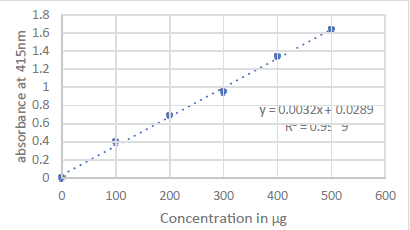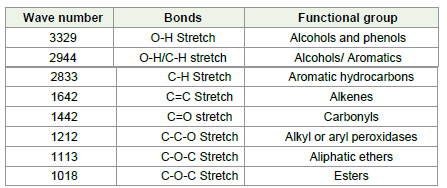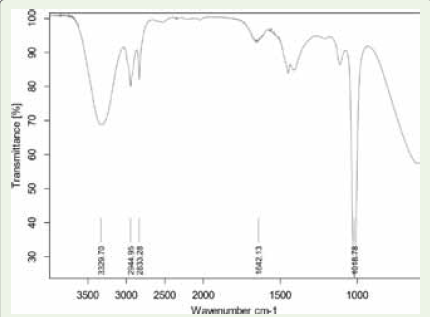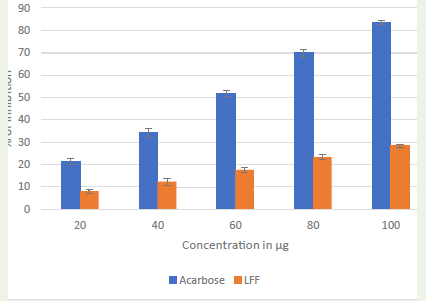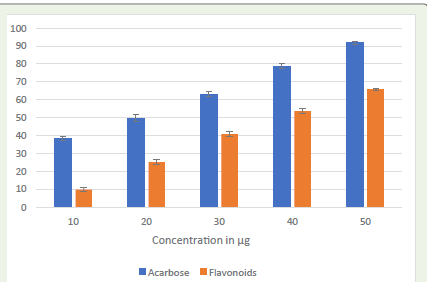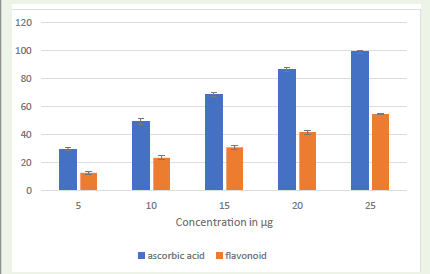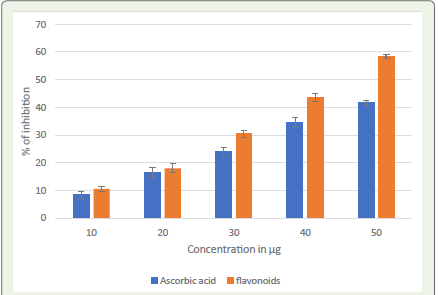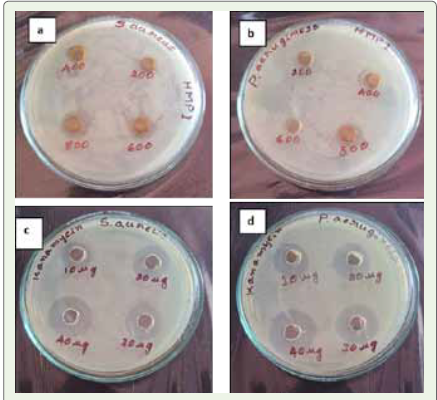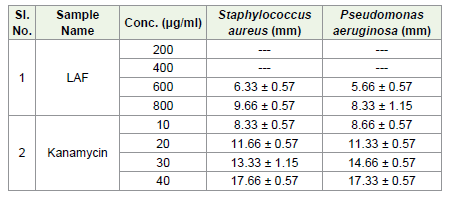Research Article
Determination of Total Flavonoid, Antioxidant, Antidiabetic, and Antibacterial Activities of Flavonoids Present In Memecylon malabaricum (C.B.Clarke) Cogn
Prathap HM*, Vadlapudi K, Manjunatha T, Ruksana F, Vishala E and Savitharani M
Department of Studies in Biochemistry, Davangere University, Shivagangothri, Karnataka, India
*Corresponding author:Prathap HM, Department of Studies in Biochemistry, Davangere University, Shivagangothri, Karnataka, India. E-mail Id: veeke2012@gmail.com
Copyright:©Prathap HM, et al. 2024. This is an open-access article distributed under the Creative Commons Attribution License, which permits unrestricted use, distribution, and reproduction in any medium, provided the original work is properly cited.
Article Information:Submission: 21/01/2024; Accepted: 12/02/2024; Published: 14/04/2024
Abstract
Flavonoids are the secondary metabolites that are found in the plants which possess the various biological properties. The present study deals with the total flavonoid content, antidiabetic, antioxidant and antibacterial activities of Leaf flavonoid fraction (LFF) isolated from M. malabaricum. Flavonoid were
isolated and quantified as previously described. Antidiabetic, antioxidant and antibacterial activities were evaluated for Leaf flavonoid fraction (LFF) of M.malabaricum leaves. The Total Flavonoid content was found to be 553.5865±18.56 mg CE/g. IC50 of LFF for α-amylase enzyme and α-glucosidase enzyme
183.95 and 37.720 μg/ml respectively. At 100 μg/ml concentration, the scavenging activity of LFF reached around 54.46% for DPPH and 58.32% for Nitric oxide. While the LFF has significantly inhibited both gram-negative Pseudomonas aeruginosa and gram-positive Staphylococcus aureus bacteria by showing
the maximum zine of inhibition of 8.33 ± 1.15 and 9.66 ± 0.57 respectively. These results exhibited that the flavonoids in LFF have the potential Antidiabetic, antioxidant and antibacterial properties.
Keywords:M. malabaricum; Flavonoid Content; Antidiabetic Activity; Antioxidant Activity; Antibacterial Activity
Introduction
Flavonoids are a broad class of polyphenolic chemicals found
in plants and other natural sources. They are divided into six
groups: flavanones, flavones, isoflavones, flavonols, flavanols, and
anthocyanins. These compounds have sparked widespread interest due
to their diverse biological actions, which include anti-inflammatory,
antioxidant, antiviral, antibacterial, anticancer, cardioprotective, and
neuro protective properties [1-5]. Flavonoids have been investigated
for their possible health advantages, and their consumption has been
linked to a variety of positive impacts on human health, making
them appealing to the medical, pharmaceutical, cosmetic, food, and
nutraceutical industries [6]. Melastomataceae is a dicotyledonous
flowering plant family that is primarily found in the tropics. There
are approximately 175 genera and 5115 recognized species. Annual
or perennial plants, shrubs, and small trees are all members of this
family[7].
Memecylon malabaricum is a plant in the family Melastomataceae.
It is indigenous to India and is found in the Western Ghats region.
The plant is well-known for its traditional usage in the treatment
of diabetes, numerous bacterial infections, inflammatory and skin
illnesses such as herpes, and chickenpox. The plant’s leaves were
tested using GC-MS, and the results revealed the presence of a variety
of bioactive chemicals [8]. Several research have been conducted on
the plant, including antihelmintic activity, anti-psoriatic, anticancer,
and antibacterial activities for the crude extract [9-12]. The crude
methanolic extract was tested for Antidiabetic efficacy in vivo
[13]. Since the crude methanolic extract may contain numerous
metabolites in it, purification of each compound is needed. For the
current investigation, we had treated the methanolic extract further
with Amberlite XAD4 for the elution of flavonoids. The current
study focuses on isolating flavonoids from a methanolic extract
of Memecylon malabaricum leaves and evaluating their in vitro
antidiabetic, antioxidant, and antibacterial effects.
Materials and Methods
Collection and preparation of plant extract:
M. malabaricum leaves were collected in Shivamogga, Karnataka,
India, specifically in Chakranagar, Hosanagar Taluk. After washing
the fresh leaves in running tap water to remove any surface impurities,
they were rinsed with distilled water and dried in the shade for 15
days, or until their dry weight remained steady. The dried leaves were
mashed using an electric blender to extract the most phytochemicals
by reducing particle size. After that, the ground leaves were sealed in
an airtight container. Using a Soxhlet apparatus, the powdered leaves
were defatted with n-Hexane, and flavonoids were isolated using
conventional procedures. Every solvent used for the extraction process
was carried out for roughly 24 hours. After concentrating through a
rotary evaporator, the resultant extract was kept refrigerated until it
was processed further.Isolation of Flavonoids:
The methanolic extract was partitioned against diethyl ether to
eliminate all non-polar components. Furthermore, non-aromatic
components other than flavonoids, such as free sugars and aliphatic
acids, were extracted from the extract via adsorption chromatography
with Amberlite XAD-4, which adsorbs polyphenolic chemicals,
including flavonoids. This was done according to [14]Dong et al.,
(2014). The adsorbed polyphenolic chemicals were eluted with 100
percent methanol. Which was then dried at 37 0C and stored at 4 0C
until further use. The Leaf Flavonoid fraction (LFF) was separated
and collected as outlined by Dong et.al.Quantification of Flavonoids:
Aluminium chloride method was used with slight modification
to determine the total flavonoid content present in LFF [15]. The
absorbance of the reaction mixture was determined at 415 nm using
a PC-based UV-visible spectrophotometer (Systronics, Model-119).
Catechin was used to create the standard curve (20-100 μg/mL), and
the results were expressed as μg of Catechin equivalents per mg of
extract.FTIR analysis of LFF:
FTIR spectroscopy was utilized to determine the type of functional
groups contained in the LFF. The LFF of M. malabaricum was
dissolved in methanol (1 mg/ml). The sample was evaluated using
Bruker FTIR spectroscopy (USIC, Davangere University, Davangere,
Karnataka, India) between 400 and 4000 cm-1. Infrared spectrum data
were collected to detect functional groups, as stated by Silverstein[16].Anti-diabetic activities:
LFF were examined for α-amylase inhibition with the
3,5-dinitrosalicylic acid method [17]. LFF’s capacity to
inhibit α-glucosidase was evaluated using p-nitrophenyl-α-D
glucopyranoside as a substrate [18]. Acarbose served as the positive
control for the both enzyme inhibition activity. The inhibitory action
was defined as the half maximum inhibitory concentration (IC50),
which measures the extract’s ability to suppress enzyme activity.Inhibitory activity (%) = (1 − As/Ac) ×100
Where, As= absorbance of sample, Ac = absorbance of control
Antioxidant activities:
The 2, 2-diphenyl-1-picryl-hydrazyl-hydrate (DPPH) method
is widely used to assess the free radical scavenging ability of natural
substances [19]. M. malabaricum’s LFF free radical scavenging
activity was assessed in comparison to DPPH. Nitric oxide radical
scavenging was also employed to determine the LFF’s antioxidant
capacity [20]. Ascorbic acid has served as the benchmark for both
radical scavenging activities.% Inhibition= Absorbance of control-Absorbance of sample X
100/Absorbance of control
Antibacterial activity:
The agar-well diffusion technique [21]was used to assess LFF’s
antibacterial activity following minor alterations. The samples were
analyzed for gram-positive Staphylococcus aureus (MTCC-7443) and
gram-negative Pseudomonas aeruginosa (MTCC-1034) bacteria. The
inoculum was adjusted to about 5 × 105 CFU/ml using sterile saline
solution. Samples were dissolved in DMSO at a concentration of 10
mg/ml to create a stock. Concentrations ranging from 200-800 μg/
ml were separated into distinct wells. Every antibacterial activity was
performed using Mueller Hinton agar medium[38]. Microorganisms
were cultivated at 37 0C, and the inhibitory zone diameter (in
millimeters, mm) was determined.Determination of Minimum Inhibitory Concentration (MIC): The minimal inhibitory concentration (MIC) and minimum
bactericidal concentration (MBC) were determined using the broth
dilution technique [22]. Samples were diluted in DMSO from 0 to 800
μg/ml (w/v) of stock solutions. The samples were examined for gram negative
Pseudomonas aeruginosa (MTCC-1034) and gram-positive
Staphylococcus aureus (MTCC-7443). Using a micro-pipette, add 10
μl of inoculum adjusted to 5 x 105 CFU/ml to the appropriate wells
and mix with the growth medium. Bacterial plates were incubated
for 48 hours at 37 0C. The MIC values show the lowest quantity that
inhibits the growth of the tested microorganisms. After incubation,
50 μl of test-culture from the obviously inhibited well was put on an
agar well plate and incubated. The concentration with no growing
colony was determined MBC.
Results and Discussion
Total flavonoid analysis:
Total flavonoid content was quantified using aluminum chloride
method. Numerous important phytochemicals have shown their
strong presence that has proved the way to estimate the flavonoid
content in M. malabaricum leaf flavonoid fraction. The yield of
flavonoid rich M. malabaricum leaf flavonoid fraction recorded
as 553.5865±18.56 mg of catechin equivalents per mg of LFF (Y =
0.0032x + 0.0289, R2 = 0.9969; Y = 1.8373). The linear regression of
leaf flavonoid fraction represented in [Figure 1].Fourier transforms infrared spectrometer (FTIR):
Infrared spectrum can be obtained due to the molecular vibration
by the solid, liquid, or gas samples through absorbing or emitting
of infrared ray. The method of obtaining the spectrum is known as
Fourier-transform infrared spectroscopy (FTIR) [23]. The FTIR
spectra of flavonoids have been extensively studied, and the flavonoid
structure shares certain wavenumber ranges [24]. The results obtained
from the FTIR spectra of M. malabaricum LFF [Figure 2] confirmed
the existence of several functional groups associated to flavonoids,
which are listed in [Table 1] .The FTIR Spectrum of flavonoids exhibits the carbonyl frequency
at 1642cm-1. The substituents such as hydroxyl/alkyl at 3 or 5 position
do not markedly affect the carbonyl frequency. IR spectra of leaf
flavonoid fraction showed frequencies at 3329 cm-1 and at 2944–
2833 cm-1 indicating the presence of hydroxyl group and C–H in
conjugation, respectively and the absorption peaks at 1642, and 1442
cm-1 indicated the presence of C=O group and unsymmetric ethylenic
double bond and aromatic rings [25,26]. Presence of -OH, and -C=O
absorption bands are characteristics of flavonoids.
Antidiabetic activities:
Enzymes like α-amylase and α-glucosidase hydrolyze starch intomaltose and glucose. Although different prescribed anti-diabetic
medicines can help treat diabetes mellitus, they have a number of
negative effects. A naturally occurring selective inhibitor for α-amylase
and α-glucosidase activity is necessary [27]. The preliminary study on
the inhibition of α-Amylase in vitro [28] and in vivo (Ramaiah M
et.al., 2012) in dose dependent manner for crude methanolic extract of
M. malabaricum plant. In the present study, LFF inhibited α-amylase
by 28.45% (IC50 183.95 μg/ml), while regular Acarbose inhibited
it by 83.53% (IC50 57.31 μg/ml). LFF inhibited α-Glucosidase at
a maximum of 65.94% (IC50 37.720 μg/ml), while conventional
Acarbose inhibited α-Glucosidase at 91.69% (IC50 19.379 μg/ml). The
inhibition of α-amylase and α-glucosidase enzymes against LFF and
the standard acarbose is depicted in [Figure 3] and [Figure 4]. The
present study revealed that LFF shown the inhibition of α-amylase
and α-glucosidase enzymes in dose-dependent manner.
Antioxidant activities:
Antioxidants are chemicals that can quench free radicals and
mitigate their deleterious effects. Their functioning is dependent on
the donation of an electron, which facilitates the stability of unpairedelectrons within free radicals while remaining inert themselves.
Scavenging is a procedure that neutralizes free radicals [29].
Previous studies on the antioxidant activity of the M. malabaricum
plant utilized crude methanolic extracts exhibited the antioxidant
properties against DPPH and ABTS radicals [30,12]. In this study,
different concentrations of M. malabaricum LFF were tested using
the 2, 2-diphenyl-1-picryl-hydrazyl-hydrate (DPPH) and nitric oxide
free radical scavenging techniques. The LFF had the highest DPPH
activity of 54.46% (IC50 value 23.44 μg/ml), whereas ascorbic acid
showed around 96.9% (IC50 value of 10.242 μg/ml) (Figure 7a). The
LFF showed the highest nitric oxide radical scavenging activity at
58.32% (IC50 of 89.41 μg/ml), whereas ascorbic acid showed 41.71%
(IC50 of 59.439 μg/ml) suppression. These study reports suggested
that Memecylon malabaricum LFF have shown the significant
antioxidant properties by scavenging the DPPH and Nitric oxide
radicals.
Antibacterial activity:
Flavonoids can prevent the growth of many bacteria by interfering
with their cell membranes, energy metabolism, nucleic acid
production, and virulence factors. Flavonoids can also improve the
effectiveness of medications and reverse antibiotic resistance in some
bacteria. As a result, flavonoids are promising candidates for creating
novel antibacterial agents or adjuvants [31]. The general modes
of action of antibacterial agents include inhibiting the synthesis of
proteins and nucleic acids, damaging the integrity of cell membrane
permeability [32-35].The flavonoids are believed to depend on the
interaction with the penetration of hydrophobic core and hydrophilic
region of the phospholipids on the cellular membrane [36,37]. Several
research studies have sought out elucidate the antibacterial modes of
action of selected flavonoids as well. Previous studies found that the
Memecylon malabaricum leaves crude methanolic extract showed
the inhibition against E. coli, S. aureus, P. aeruginosa, B. subtilis, and
S. typhi [9,12]. The current study employed the agar well diffusion
technique to determine LFF’s antibacterial effectiveness against both
gram-positive and gram-negative bacteria. [Figure 7] exhibits the zone
of inhibition in agar well plates for the antibacterial efficacy of LFF
and the standard Kanamycin. [Table 3] is a compilation of bacteria’s
inhibitory zones. [Table 4] shows the MIC and MBC for LFF. All the
Figure 7:Antibacterial efficacy of LFF and standard kanamycin a. LFF
against S. aureus b. LFF against P. aeruginosa c. kanamycin against S.
aureus d. kanamycin against P. aeruginosa.
Table 2:IC50 values of DPPH and Nitric oxide invitro antioxidant efficacy of LFF
of M. malabaricum leaves
antibacterial activity was compared to standard Kanamycin. These
study reports suggested that Memecylon malabaricum leaf flavonoid
fraction have shown the significant antibacterial activity against S.
aureus and P. aeruginosa.
Conclusion
Flavonoids are a large family of polyphenols with a wide range
of biological properties, making them intriguing to researchers
from a number of fields. They have the potential to improve health
because of their high antioxidant capacity both in vivo and in vitro
systems. Their widespread existence and diversified biological
function make them a promising subject for future research and
development. The current work focuses on the anti-diabetic,
antioxidant, and antibacterial properties of flavonoids extracted from
the plant M. malabaricum cogn. The current investigation found
that LFF is containing the flavonoids those of enzyme inhibitors
for α-amylase and α-glucosidase, as well as free radical scavengers.
LFF also exhibited promise inhibition of antimicrobial activity,
which MBC subsequently corroborated. However, while flavonoids
show promising results in vitro, further research is needed to isolate
them, understand their structure and mechanism of action, and
demonstrate their therapeutic potential in vivo.
References
20. Sreejayan Rao MN (1997) Nitric oxide scavenging by curcumonoids, J. Pharm. Pharmacol. 49: 105-107.
32. Cushnie TP, Lamb AJ (2005) Antimicrobial activity of flavonoids. Int. J. Antimicr, Age, 26: 343-356.

